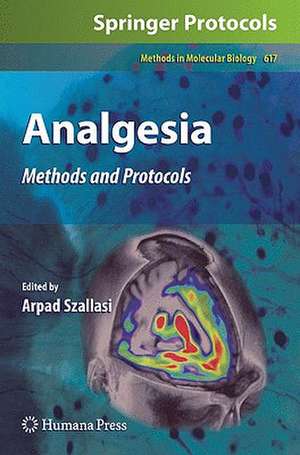Analgesia: Methods and Protocols: Methods in Molecular Biology, cartea 617
Editat de Arpad Szallasien Limba Engleză Hardback – 25 mar 2010
Comprehensive and essential, Analgesia: Methods and Protocols promises to aid and enrich the research of all those scientists and clinicians who are interested in what the increasingly molecular future has in store for analgesia research, from the molecular research bench through the animal laboratory to the bedside.
| Toate formatele și edițiile | Preț | Express |
|---|---|---|
| Paperback (1) | 802.01 lei 6-8 săpt. | |
| Humana Press Inc. – 23 aug 2016 | 802.01 lei 6-8 săpt. | |
| Hardback (1) | 1125.88 lei 6-8 săpt. | |
| Humana Press Inc. – 25 mar 2010 | 1125.88 lei 6-8 săpt. |
Din seria Methods in Molecular Biology
- 9%
 Preț: 791.59 lei
Preț: 791.59 lei - 23%
 Preț: 598.56 lei
Preț: 598.56 lei - 20%
 Preț: 882.95 lei
Preț: 882.95 lei -
 Preț: 252.04 lei
Preț: 252.04 lei - 5%
 Preț: 802.69 lei
Preț: 802.69 lei - 5%
 Preț: 729.61 lei
Preț: 729.61 lei - 5%
 Preț: 731.43 lei
Preț: 731.43 lei - 5%
 Preț: 741.30 lei
Preț: 741.30 lei - 5%
 Preț: 747.16 lei
Preț: 747.16 lei - 15%
 Preț: 663.45 lei
Preț: 663.45 lei - 18%
 Preț: 1025.34 lei
Preț: 1025.34 lei - 5%
 Preț: 734.57 lei
Preț: 734.57 lei - 18%
 Preț: 914.20 lei
Preț: 914.20 lei - 15%
 Preț: 664.61 lei
Preț: 664.61 lei - 15%
 Preț: 654.12 lei
Preț: 654.12 lei - 18%
 Preț: 1414.74 lei
Preț: 1414.74 lei - 5%
 Preț: 742.60 lei
Preț: 742.60 lei - 20%
 Preț: 821.63 lei
Preț: 821.63 lei - 18%
 Preț: 972.30 lei
Preț: 972.30 lei - 15%
 Preț: 660.49 lei
Preț: 660.49 lei - 5%
 Preț: 738.41 lei
Preț: 738.41 lei - 18%
 Preț: 984.92 lei
Preț: 984.92 lei - 5%
 Preț: 733.29 lei
Preț: 733.29 lei -
 Preț: 392.58 lei
Preț: 392.58 lei - 5%
 Preț: 746.26 lei
Preț: 746.26 lei - 18%
 Preț: 962.66 lei
Preț: 962.66 lei - 23%
 Preț: 860.21 lei
Preț: 860.21 lei - 15%
 Preț: 652.64 lei
Preț: 652.64 lei - 5%
 Preț: 1055.50 lei
Preț: 1055.50 lei - 23%
 Preț: 883.85 lei
Preț: 883.85 lei - 19%
 Preț: 491.88 lei
Preț: 491.88 lei - 5%
 Preț: 1038.84 lei
Preț: 1038.84 lei - 5%
 Preț: 524.15 lei
Preț: 524.15 lei - 18%
 Preț: 2122.34 lei
Preț: 2122.34 lei - 5%
 Preț: 1299.23 lei
Preț: 1299.23 lei - 5%
 Preț: 1339.10 lei
Preț: 1339.10 lei - 18%
 Preț: 1390.26 lei
Preț: 1390.26 lei - 18%
 Preț: 1395.63 lei
Preț: 1395.63 lei - 18%
 Preț: 1129.65 lei
Preț: 1129.65 lei - 18%
 Preț: 1408.26 lei
Preț: 1408.26 lei - 18%
 Preț: 1124.92 lei
Preț: 1124.92 lei - 18%
 Preț: 966.27 lei
Preț: 966.27 lei - 5%
 Preț: 1299.99 lei
Preț: 1299.99 lei - 5%
 Preț: 1108.51 lei
Preț: 1108.51 lei - 5%
 Preț: 983.72 lei
Preț: 983.72 lei - 5%
 Preț: 728.16 lei
Preț: 728.16 lei - 18%
 Preț: 1118.62 lei
Preț: 1118.62 lei - 18%
 Preț: 955.25 lei
Preț: 955.25 lei - 5%
 Preț: 1035.60 lei
Preț: 1035.60 lei - 18%
 Preț: 1400.35 lei
Preț: 1400.35 lei
Preț: 1125.88 lei
Preț vechi: 1185.14 lei
-5% Nou
Puncte Express: 1689
Preț estimativ în valută:
215.43€ • 225.54$ • 178.26£
215.43€ • 225.54$ • 178.26£
Carte tipărită la comandă
Livrare economică 05-19 aprilie
Preluare comenzi: 021 569.72.76
Specificații
ISBN-13: 9781603273220
ISBN-10: 1603273220
Pagini: 518
Ilustrații: XVII, 560 p.
Dimensiuni: 178 x 254 x 40 mm
Greutate: 1.2 kg
Ediția:2010
Editura: Humana Press Inc.
Colecția Humana
Seria Methods in Molecular Biology
Locul publicării:Totowa, NJ, United States
ISBN-10: 1603273220
Pagini: 518
Ilustrații: XVII, 560 p.
Dimensiuni: 178 x 254 x 40 mm
Greutate: 1.2 kg
Ediția:2010
Editura: Humana Press Inc.
Colecția Humana
Seria Methods in Molecular Biology
Locul publicării:Totowa, NJ, United States
Public țintă
Professional/practitionerCuprins
Alternatives to Mammalian Pain Models 1: Use of C. elegans for the Study of Volatile Anesthetics.- Alternatives to Mammalian Pain Models 2: Using Drosophila to Identify Novel Genes Involved in Nociception.- Animal Models of Acute Surgical Pain.- Animal Models of Acute and Chronic Inflammatory and Nociceptive Pain.- Noxious Heat Threshold Measured with Slowly Increasing Temperatures: Novel Rat Thermal Hyperalgesia Models.- Locomotor Activity in a Novel Environment as a Test of Inflammatory Pain in Rats.- Rationale and Methods for Assessment of Pain-Depressed Behavior in Preclinical Assays of Pain and Analgesia.- Animal Models of Orofacial Pain.- Migraine Models.- Experimental Models of Visceral Pain.- Human Correlates of Animal Models of Chronic Pain.- Human Experimental Pain Models 1: The Ultraviolet Light UV-B Pain Model.- Human Experimental Pain Models 2: The Cold Pressor Model.- Human Experimental Pain Models 3: Heat/Capsaicin Sensitization and Intradermal Capsaicin Models.- The Value of the Dental Impaction Pain Model in Drug Development.- Live Cell Imaging for Studying G Protein-Coupled Receptor Activation in Single Cells.- Recombinant Cell Lines Stably Expressing Functional Ion Channels.- Ion Channels in Analgesia Research.- Electrophysiological and Neurochemical Techniques to Investigate Sensory Neurons in Analgesia Research.- The Genetics of Pain and Analgesia in Laboratory Animals.- RT-PCR Analysis of Pain Genes: Use of Gel-Based RT-PCR for Studying Induced and Tissue-Enriched Gene Expression.- Gene-Based Approaches in the Study of Pathological Pain.- Linkage Analysis and Functional Evaluation of Inherited Clinical Pain Conditions.- Rat Bone Marrow Stromal Cells and Oligonucleotides in Pain Research.- Transplantation of Human Mesenchymal Stem Cells in the Studyof Neuropathic Pain.- Delivery of RNA Interference to Peripheral Neurons In Vivo Using Herpes Simplex Virus.- Combination of Cell Culture Assays and Knockout Mouse Analyses for the Study of Opioid Partial Agonism.- Assessing Potential Functionality of Catechol-O-methyltransferase (COMT) Polymorphisms Associated with Pain Sensitivity and Temporomandibular Joint Disorders.- Genetic Polymorphisms and Human Sensitivity to Opioid Analgesics.- Molecular Assays for Characterization of Alternatively Spliced Isoforms of the Mu Opioid Receptor (MOR).- Inhalational Anesthetic Photolabeling.- Measuring Membrane Protein Interactions Using Optical Biosensors.- Proteomics and Metabolomics and Their Application to Analgesia Research.- Preemptive Analgesia: Problems with Assessment of Clinical Significance.- Standardization of Pain Measurements in Clinical Trials.- Procedural Sedation and Analgesia Research.- Non-invasive Transcranial Direct Current Stimulation for the Study and Treatment of Neuropathic Pain.- Pain Imaging in the Emerging Era of Molecular Medicine.- Current and Emerging Pharmacologic Therapies for Pain and Challenges Which Still Lay Ahead.
Recenzii
From the reviews:
“The text provides all one wishes to know about research methods in analgesia. … editor’s decision to invite groups of authors and experts from the different areas of research in analgesia, has allowed a broad and up-to-date view of the field. … This book is of great value for investigators, students and physicians interested in understanding pain and the mechanisms involved in its relief. On consulting this book, researchers, students and professionals will have the opportunity to update their knowledge of experimental methods in analgesia.” (Zuleica Bruno Fortes, Brazilian Journal of Pharmaceutical Sciences, Vol. 46 (4), October-December, 2010)
“This book is a collection of methods used to study pain physiology, pharmacology, and genetics described by researchers in the field. … intended to assist basic scientists and clinicians who are interested in the molecular aspects of pain research. … This is a most unique book in the field of pain medicine. … The book imparts a lot of information about the future of pain medicine and is a must read for pain physicians who want to be at their best when managing their patients.” (Tariq M. Malik, Doody’s Book Reviews, August, 2010)
“The text provides all one wishes to know about research methods in analgesia. … editor’s decision to invite groups of authors and experts from the different areas of research in analgesia, has allowed a broad and up-to-date view of the field. … This book is of great value for investigators, students and physicians interested in understanding pain and the mechanisms involved in its relief. On consulting this book, researchers, students and professionals will have the opportunity to update their knowledge of experimental methods in analgesia.” (Zuleica Bruno Fortes, Brazilian Journal of Pharmaceutical Sciences, Vol. 46 (4), October-December, 2010)
“This book is a collection of methods used to study pain physiology, pharmacology, and genetics described by researchers in the field. … intended to assist basic scientists and clinicians who are interested in the molecular aspects of pain research. … This is a most unique book in the field of pain medicine. … The book imparts a lot of information about the future of pain medicine and is a must read for pain physicians who want to be at their best when managing their patients.” (Tariq M. Malik, Doody’s Book Reviews, August, 2010)
Textul de pe ultima copertă
Chronic pain is a complex phenomenon, which continues to remain undertreated in the majority of affected patients thus representing a significant unmet medical need, but the development of cellular, subcellular, and molecular methods of approaching this epidemic of pain shows great promise. In Analgesia: Methods and Protocols, experts in the field present thorough coverage of molecular analgesia research methods from target discovery through target validation and clinical testing to tolerance and dependence, with extensive chapters on emerging receptor classes as targets for analgesic drugs and innovative analgesic strategies. As a volume in the highly successful Methods in Molecular Biology™ series, the chapters include introductions to their respective topics, lists of the necessary materials and reagents, step-by-step, readily reproducible protocols, and notes sections with tips on troubleshooting and avoiding known pitfalls.
Comprehensive and essential, Analgesia: Methods and Protocols promises to aid and enrich the research of all those scientists and clinicians who are interested in what the increasingly molecular future has in store for analgesia research, from the molecular research bench through the animal laboratory to the bedside.
Comprehensive and essential, Analgesia: Methods and Protocols promises to aid and enrich the research of all those scientists and clinicians who are interested in what the increasingly molecular future has in store for analgesia research, from the molecular research bench through the animal laboratory to the bedside.
Caracteristici
Presents a framework of basic and clinical studies aimed at developing improved analgesic drugs Contains detailed protocols for studying both ion channels and G protein-linked receptors as targets for analgesics Delves into subjects as diverse as alternatives to animal pain models (e.g. C. elegans and Drosophila), photoaffinity labeling of volatile analgesic drugs, standardization of pain measurements in clinical trials, congenital insensitivity to pain, and personalized medicine Includes supplementary material: sn.pub/extras












